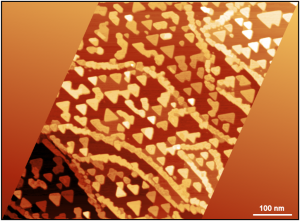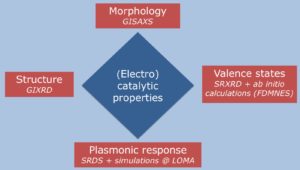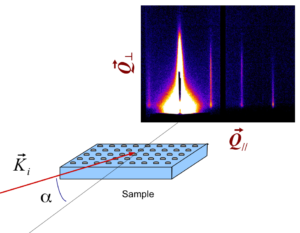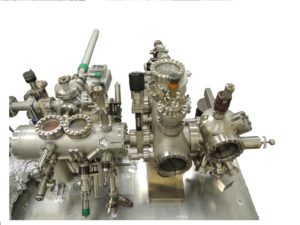- Accueil
- Institut Néel
- Équipes de recherche
- Pôles & Services techniques
- Travailler à l’institut
- Partenariats
- Actualités
- Agenda
- Annuaire
One of our key motivating factor is to investigate and to understand the new properties (and potentially, new functionalities) of low-dimensional systems, arising from size reduction.
We therefore study the structural, magnetic and electronic properties of various systems, such as bulk materials, thin films, nanostructures, surfaces and interfaces (solid/gas and solid/liquid). Besides, we also develop theories for the ab initio simulation and the understanding of experiments related to X-ray absorption and scattering processes.
Synchrotron techniques and the development of original experimental set-ups are among our core activities, frequently coupled to other laboratory tools (magnetometry…). We built several instruments and ensure their joint management at synchrotrons: a resonant X-ray diffractometer at SOLEIL and an UHV diffractometer at ESRF. In laboratory, we run a variable temperature STM and a reactor for operando catalysis.

Our main research topics are :
Nanosystems for magnetism: fonctional magnetic oxyde films, configuration and interfaces of magnetic heterostructures and, skyrmions
(Electro-) Catalysis and nanostructures for energy: catalysis by gold, 2D arrays of nanoparticles, electrochemical interfaces and, TMO films for energy
Theory of X-ray Spectroscopies: to develop an ab initio computation code which simulates the experimental spectroscopies characterizing the materials
Permanent staff: Maurizio De Santis, Farid Fettar, Jean-Marc Tonnerre
Students: Vartika Bansal (PhD), Intan Kusumaningrum
*************** Under construction ***************
Permanent staff: Jean-Marc Tonnerre
*************** Under construction ***************
Permanent staff: Farid Fettar
Skyrmion generation needs also multilayer structures such as Ta/[Fe/Gd]n/Ta. They are model systems for topologically protected spin textures, emphasizing the role of topology in the classification of complex states of condensed matter. We want to develop forefront aspect of this research field by developing and charactarizing transition-metal-based magnetic multilayer structures that support skyrmionic states at room temperature and allow for the precise control of skyrmions. We will use Fourier Transform Holography methods, in collaboration with the SEXTANTS beamline (SOLEIL) to investigate their generation. Our objectives are: (i) study of correlation of skyrmionics phases with magnetisation using anomalous Hall effect under controlled magnetic field and at room temperature; (ii) topological structural stabilisation of skyrmionics phases (different geometry of the Holography sample aperture) ; (iii) tuning Dzyaloshinskii–Moriya Interaction (DMI, different bottom and top non-magnetic layers).
Jean-Paul Itié, Synchrotron Soleil, France
Alberto Caneiro, CEA Bariloche, Argentina
Nestor Massa, Univ. Nacional La Plata, Argentina
Antonio Alonso, Instituto de Ciencia de Materiales de Madrid
Cinthia Piamonteze, Advanced Light Source, Berkeley, USA
Flávio Garcia, LNLS, Campinas, Brazil
Alessandro Martins – Universidade Federal de Goiás, Brazil
Antônio D. Dos Santos, Depto de Física Materiais e Mecânica, IF- USP, Sao Paulo, Brazil
Pascal Andreazza et Caroline Andreazza-Vignolle, CMRD Orleans
Synthesizing model catalysts with a controlled architecture is a promising way for understanding the respective influence of atomic-scale parameters (crystallographic structure, morphology, chemical composition…) on their catalytic properties.
Our approach is twofold:
The scientific approach is similar in both cases and intends to give a detailed description of the model catalysts behaviour in semi-realistic conditions. It implies to control their growth and finely characterize the interfaces with the gaseous or liquid medium. The model catalysts consist in thin metallic films or nanoparticles of noble metals deposited on another noble metal or an oxide single-crystal. Complementary synchrotron X-ray-based techniques, such as Grazing Incidence X-Ray Diffraction (GIXRD) and Grazing Incidence Small-Angle X-Ray Scattering (GISAXS), are used to determine structural and morphological parameters.

Permanent staff: Marie-Claire Saint-Lager, Aude Bailly, Yvonne Soldo-Olivier, Stéphanie Garaudée (Epitaxy and layer deposition technological group)
Former PhD student: Antoine Abisset
Harvesting solar radiation, a clean and inexhaustible source of energy, is a key challenge. Semiconductors have been intensively studied for their capacity to absorb photons and create active electrons and holes able to trigger the reduction or oxidation of chemicals. Unfortunately, the response of the most active materials, like TiO2, is restricted to the ultraviolet (UV), therefore limiting the possibility to efficiently use sunlight (~ 5 % UV, 45% visible, 50% IR). Several ways have been explored in order to overcome this limitation, but efficiency and stability still remain challenging. A promising recent approach takes advantage of the unique ability of some noble metal NPs (like Au) to absorb light at specific wavelengths across the visible part of the electromagnetic spectrum via localized surface plasmon resonances (LSPR). A strong enhancement of the photo-reactivity under visible light is observed when these NPs are supported on a semiconductor photocatalyst. Interestingly, a modulation of the plasmonic response and hence of the photocatalytic behavior can be achieved by playing with the NPs features (composition, shape, structure, interparticle distance, environment). In this context, our innovating approach is to consider Au-based NPs supported on well-defined substrates (model systems) and to characterize their structure, morphology and LSPR properties using operando optical and synchrotron X-Ray techniques.
We studied Au NPs supported on a stoichiometric TiO2(110) single crystal by following operando, during their growth, the optical response with Surface Differential Reflectivity Spectroscopy (SDRS) and the structural/morphological properties (size, shape, lattice parameter…) with Grazing Incidence X-Ray Diffraction (GIXRD) and Grazing Incidence Small Angle X-Ray Scattering (GISAXS)[1]. Experiments were made at the SIXS beamline at SOLEIL synchrotron source, equipped with a Molecular Beam Epitaxy apparatus for NP deposition in Ultra High Vacuum conditions and SDRS measurements were made thanks to our home-made setup, specially transported and installed.
Typically, the position of the plasmon peak in S polarization (fig. 1) blue-shifts when the NP size decreases, with the same linear dependence not only between our samples, but also compared to Au NPs embedded in Al2O3. This suggests that the underlying quantum size effect (balance between s-electrons spill-out and diminishing of d-electrons screening for surface atoms) is an intrinsic property of the NPs.
Despite this similarity, our data clearly show the large influence of the surface state on LSPR. The red shift for a definite D size in the case of S2 is the signature of a weaker NP-substrate interaction, pointed out also by our GIXRD data, possibly due to the presence of a larger number of impurities/steps for this last sample. Also, P polarization signals (not shown here) indicate that plasmonic modes perpendicular to the surface, negligible for S1, become significant for NP smaller than about 4 nm in the case of S2. We interpret this observation as due to different growth mechanisms (nucleation sites, shape…) on S2. Adding of Pd even in small quantities largely modifies plasmonic response, which completely disappears in alloyed Au70Pd30 NPs.
[1] Thesis of Antoine Abisset, defense June 26, 2018.
Permanent staff: Aude Bailly, Maurizio De Santis, Marie-Claire Saint-Lager
Active collaborations:
Georges Sitja, Claude R. Henry (CINaM, Marseille)
Aimeric Ouvrard (ISMO, Orsay)
Natalia Alyabyeva (CEA, Saclay)
Rémi Lazzari (INSP, Paris)
Nanostructured substrates are used in order to grow arrays of ordered metallic nanoparticles for applications in various fields, such as catalysis, molecular electronics and magnetism. A robust template consists of a thin alumina film grown by direct oxidation of a Ni3Al(111) single-crystal surface. The metallic nanoparticles are subsequently grown by physical deposition and tend to be nicely ordered on the whole substrate surface.
The topics presented hereafter deal with this specific oxide template, but differ by the nature of the metallic species forming the nanoparticles.
Single-Atom Catalysis
Clusters containing a small number of atoms can exhibit unique chemical properties. They are very interesting for catalysis as the addition or removal of even a single atom can induce a change in the clusters’ chemical activity. Single-atom catalysis constitutes a new exciting frontier in the field of heterogeneous catalysis and is now becoming accessible thanks to the development of new catalyst preparation methods and powerful characterization techniques. One of the most used catalysts in industrial processes and in diesel-vehicle catalytic convertors is platinum (Pt), which is among the most expensive catalyst materials. So the interest of single-atom catalysis becomes evident both from an economics point-of-view and regarding the preservation of natural resources. The possibility to grow ordered arrays of tiny monodisperse Pt clusters can pave the way to a better understanding of the link between atomic-scale properties and catalytic performance.
For a quick overview of this topic, see the 2019 Highlights of the Institut Néel (article page 9).
Otherwise: G. Sitja et al., Regular Arrays of Pt Clusters on Alumina: A New Superstructure on Al2O3/Ni3Al(111), J. Phys. Chem. C 123 (2019) 24487. DOI: 10.1021/acs.jpcc.9b05109
Ordered Arrays of Bimetallic Nanoparticles
Producing arrays of metallic nanoparticles regularly distributed on a substrate and with a sharp size distribution is a major challenge for understanding the macroscopic properties (catalytic, magnetic, optical and so on) of the nanoparticles. These tailored systems allow to better disentangle the effect of each parameter (structural, morphological or chemical) on a given property, by fixing some characteristics in a selective and controlled way.
Through a long-standing collaboration with the CINaM, we acquired a strong expertise in synthesizing and characterizing ordered arrays of (bi)metallic nanoparticles with a focus on their catalytic properties. Over the last years, we were mainly interested in Pd-Au nanoparticles studied by combining in situ GISAXS and GIXRD during their growth.

GISAXS principle and image obtained for a 0.1 ML Pd deposit on Al2O3/Ni3Al(111)
Related paper: A. Bailly et al., Influence of Palladium on the Ordering, Final Size, and Composition of Pd−Au Nanoparticle Arrays, J. Phys. Chem. C 121 (2017) 25864. DOI: 10.1021/acs.jpcc.7b08254
More recently, we also get involved in the in situ characterization of Pd-Ag nanoparticles arrays used as templates for molecular electronics. This work was performed through the ANR JCJC « LEMON » project (PI: A. Ouvrard). The systems are characterized by a combination of GISAXS/GIXRD, STM, DRS and SFG in order to get a thorough description of their structural, morphological and optical properties. These ordered nanoparticles are then intended to be cross-linked by organic molecules.
Permanent staff: Yvonne Soldo-Olivier, Maurizio De Santis, Yves Joly
Collaborations: Eric Sibert (LEPMI)
Electro-catalysts allow speeding up electrochemical reactions typically occurring at the electrochemical interface, singular domain of some Ångstrom of thickness where the charge exchange between the conducting electrode and the electrolyte occurs. Such materials have important applications in several domains, like energy storage, chemical synthesis, bio-sensors… In this context, the description of the electrochemical interface and the comprehension of the related electro-catalytic mechanisms are of primary importance. It is first and foremost a question of material of electrode and more specifically a problem of structural and electronic properties of its surface.
We investigate the electrochemical growth of ultra-thin metallic films deposited onto single crystals (for instance, Pd/Pt(111), Pd/Au(111)…) representing a model system for fundamental studies of important reactions such as CO oxidation, oxygen reduction, or hydrogen storage processes. We perform in situ Grazing Incidence X-Ray Diffraction (GIXRD) studies at the D2AM beamline (ESRF), using dedicated home-made cells adapted both to synchrotron experiments and to electrochemistry. This technique is an excellent tool to describe the growth, structure and morphology of electro-deposited films, highlighting the influence of the chemical nature, structure and orientation of the substrate.
Very recently, we focused our attention on in situ Surface Resonant X-Ray Diffraction (SRXRD) spectroscopy. Indeed, there is currently no experimental method to specifically probe the electronic structure of the surface directly under electrochemical operation. In this frame, we aim at developing SRXRD, coupled to theoretical description using the recent extension of the FDMNES software, into a standard technique to probe charge distribution and electronic densities for electrochemical systems in in situ conditions.
Permanent staff: Aude Bailly
This research topic is focused on establishing the relationship between the structure of oxide films and their macroscopic properties (magnetic, electronic or optical). It relies on the long-standing experience we have for the controlled synthesis of such systems by MBE (Molecular Beam Epitaxy) and their consecutive in situ or ex situ characterization using laboratory and synchrotron techniques. Typical surface science methods, such as LEED, STM and AES, are complemented by atomically and chemically-resolved synchrotron X-ray-based techniques. Recently, we also took advantage of the capabilities of a new laboratory X-ray diffractometer (SmartLab, Rigaku) to study the crystallographic structure of epitaxial films of VO2 deposited on Al2O3(0001), in collaboration with the MRS team.
VO2 films for smart devices
Collaborations:
@ Institut Néel: Aline Ramos, Stéphane Grenier, Lætitia Laversenne, Pierre Bouvier, Laurence Magaud
Mohamed Chaker (INRS, Varennes, Canada)
Former post-doc students: Michelle M. Villamayor and Michael Gaudin
In bulk form, vanadium dioxide (VO2) exhibits a first-order insulator-metal transition (IMT) at 68°C. This transition temperature, called TMIT, can be tuned by strain engineering, either by growing epitaxial VO2 films on various susbtrates or/and by elemental doping.
This research topic benefits from a complementary approach, coupling High-Resolution X-ray Diffraction in laboratory, Raman spectroscopy, X-ray absorption spectroscopy (XANES, EXAFS) and DFT calculations. These techniques are used to characterize the structural and electronic properties of the VO2 films across the IMT.
We aim at understanding the effect of strain, resulting from domain-matching epitaxy or from the inclusion of a dopant element, on the shift of temperature hysteresis. In this context, pure VO2 films epitaxially grown on Al2O3(0001), a.k.a. c-cut sapphire, are studied, as well as W- and B-doped VO2 films on c- and r-Al2O3.
KBNNO ferroelectrics ceramics
Collaborations: (Institut Néel) Aline Ramos, Céline Darie
A new research direction towards inorganic perovskite thin films of ferroelectric materials for energy-related applications. These low-cost, non-toxic and chemically stable films are attractive as potential building blocks for photovoltaic devices. We will focus on systems based on solid solutions of classical ferroelectric perovskites, such as KNbO3, in order to tune the bandgap to a specific part of the solar spectrum. This topic will benefit from the local resources we have in sample synthesis, as well as laboratory and synchrotron X-ray facilities.
Permanent staff : Yves Joly, Yvonne Soldo-Olivier
Former PhD student: Oana Bunau
The purpose of this theme is to improve the understanding and the quantitative analysis of the X-ray spectroscopies as a probe of the electronic and structural properties of the materials. Most often recorded at synchrotron, x-ray absorption spectroscopy, x-ray emission spectroscopy, elastic and inelastic resonant scattering, among other techniques, need the development of tools following the improvements of the experimental capacities. It is the purpose of the FDMNES project
 Its aim is to supply to the community a user friendly ab initio code to simulate all these spectroscopies.
Its aim is to supply to the community a user friendly ab initio code to simulate all these spectroscopies.
FDMNES is mainly mono-electronic and uses the density functional theory (DFT). It includes also multi-electronics advances with the use of the time dependant DFT (TD-DFT) for a better taking into account of the excited states linked to the photon-matter interaction.
More information and download at: http://fdmnes.neel.cnrs.fr
Our team is involved in several instrumental developments linked to synchrotron radiation facilities (ESRF and SOLEIL) and implying Ultra High Vacuum (UHV) technologies:
In laboratory, we manage a variable-temperature Scanning Tunneling Microscope (VT-STM).
Besides, the main techniques we use are:
Permanent staff: Maurizio De Santis, Lucio Martinelli (CRG technological group)
Collaborations: Xavier Torelles, Institut de Ciencia de Materia, Barcelona, Spain
Permanent staff: Jean-Marc Tonnerre
Collaborations: Stéphane Grenier (MRS team)
Reference for instrument: N. Jaouen et al., J. Synchrotron Rad. (2004). 11, 353-357
Dynamic X-ray reflectivity (off- or on- resonance regime for isotropic, anisotropic and magnetic multilayers) simulation program » or « Dyna… » is a simulation tool to analyze structural, magnetic and electronic profiles along the growth direction of ultrathin layers. It simulates conventional X-ray or optical reflectivity, resonant (or « anomalous ») x-ray reflectivity, « orbital reflectometry », magnetic resonant X-ray reflectivity with applications to magnetic or anisotropic layers, in hard or soft matter.
More information and download are possible from the MRS team web page.
Permanent staff: Marie-Claire Saint-Lager
It is difficult to characterize industrial catalysts (usually nanoparticles supported on oxide powders) at the atomic scale. Thus the fundamental research in heterogeneous catalysis, aiming at understanding the catalytic processes at the molecular scale, is performed under UHV using model catalysts such as single-crystal surfaces. The recent development of surface science tools, such as surface X-ray diffraction and GISAXS, allows to overcome the two limits of this approach which are the so-called « pressure gap » (studying catalyst surfaces in pressure and temperature conditions close to the ones of the reaction) and the « material gap ».
This reactor project is inserted in this very active research field. The aims are:
(i) to follow the surface structure, composition and morphology of the model catalysts from the UHV environment where they are elaborated up to the reaction conditions (atmospheric pressure and temperature above the room temperature)
(ii) to extend the study from single-crystal surfaces to thin epitaxial films and to nanoparticles supported on oxide.
The experimental set-up is composed of two main parts: (1) the reactor itself with beryllium windows for X-ray experiments. It is equipped with pumping systems and suitable pressure measurements for UHV up to atmospheric pressure, a reactive gas input and a mass spectrometer. The connection to the GMT diffractometer is ensured via a goniometer head for high-accuracy sample alignment. It is also equipped for UHV preparation of single-crystal surfaces (Ar+ sputtering and sample annealing). (2) the choice of a vertical surface allows a simple transfer from a UHV preparation chamber, equipped with the usual tools of surface science (LEED, AES, evaporation sources, …). It takes also benefit from the direction with the smallest natural divergence of the x-ray beam delivered by a bending magnet: Bragg’s peaks of the (vertical) surface plane are studied with the best angular resolution and the maximum photon flux (slits opened).
The first experiment to check the sole reactor part was performed in January 2005. It has confirmed and completed the results previously obtained on ID03 dealing with the selective butadiene hydrogenation on Pd8Ni92(110). The whole system (reactor + preparation chambers) should be checked in march 2006 in GMT.
Permanent staff: Maurizio de Santis, Aude Bailly
Collaborations: Véronique Langlais

VT-STM (right) and its UHV preparation chamber (left)
Under progress
Below is the list of topics proposed by the team for internships, as well as positions with a readily-available funding (PhD, Post-doc and so on).
Sorry ! No job offer at present.
Person in charge: Yvonne SOLDO
Students & Post-docs & CDD
Maurizio DE-SANTIS
Personnel Chercheur - CNRS
Maurizio.De-Santis [at] neel.cnrs.fr
Phone: 04 76 88 74 13
Office: F-409
Farid FETTAR
Personnel Chercheur - CNRS
Farid.Fettar [at] neel.cnrs.fr
Phone: 04 76 88 74 15
Office: F-411
Yvonne SOLDO
Personnel Chercheur - CNRS
yvonne.soldo [at] neel.cnrs.fr
Phone: 04 76 88 74 12
Office: F-408
Jean-Marc TONNERRE
Personnel Chercheur - CNRS
Jean-Marc.Tonnerre [at] neel.cnrs.fr
Phone: 04 76 88 74 15
Office: F-411
Anjali YADAV
Personnel Chercheur - UGA
anjali.yadav [at] neel.cnrs.fr
Office: F-323
Referent: Maurizio DE-SANTIS
